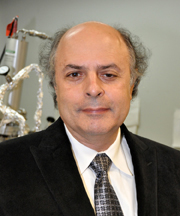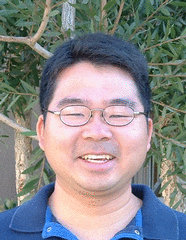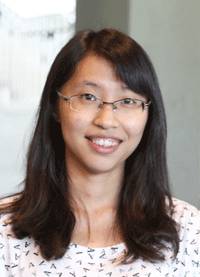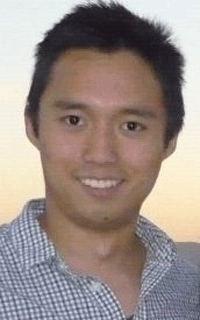February 2015 Newsletter: Volume 2, Issue 1
A Message from the Director, Jian-Ping Wang
Welcome to our Quarterly Newsletter. This quarter, we have a short and exciting research story about Theme 2, one of the keys to the success of our Center. For me, stories like this show the fundamental impact of our research. Thanks to Mike Lotti for his efforts to put the Newsletter together. But first, a look behind and a look ahead:
A fruitful and exciting 2014. C-SPIN now consists of thirty-two researchers and 137 registered students and postdoctoral fellows from nineteen top U.S. universities. In 2014, C-SPIN researchers published 148 papers, presented 63 talks and 42 posters, and submitted four new IPs and one new software description. One highlight for C-SPIN came when Prof. Weigang Wang's group at the Univ. of Arizona, together with researchers from Argonne National Lab and C-SPIN theoretician Oleg Mryasov, demonstrated voltage-controlled magnetism (VCM) in Co thin films adjacent to Gd2O3 gate oxides, as reported in Physical Review Letters (P071863). This work is directly connected to earlier research by C-SPIN PI Geoff Beach of MIT, whose paper reported that magnetic properties of ultrathin Co films adjacent to Gd2O3 gate oxides can be directly manipulated at small voltages. In particular, a few volts can switch a Co film from having strong perpendicular anisotropy to having in-plane anisotropy and even no anisotropy. Moreover, these switches are non-volatile -- that is, they do not need continued applied voltage to maintain their new magnetic state. Power requirements for spin-based switching have been an obstacle to spin computing for quite some time, so observing and understanding this super-efficient switching opens to doors to many new spin-based devices. As another highlight, C-SPIN PIs Kim, Sapatnekar, Koester, Crowell, and JP Wang recently completed a benchmarking study of all-spin-logic devices and published the details in, “Spin Based Computing: Device Concepts, Current Status, and a Case Study on a High Performance Processor” (SRC P072304); J. Kim et al, Proceedings of IEEE, 2015). Technical barriers associated with spin devices such as low spin injection, limited spin diffusion length, and intrinsically high activity factor have been identified and analyzed in great detail. These are two of many examples of C-SPIN PIs proactively collaborating across their specialties to develop spin logic and memory.
The challenge of 2015. C-SPIN begins its third year with PIs and students knowing how to work together to carry out impactful research based on our sponsors’ guidance. The main challenge has not changed: to identify and acknowledge the fundamental issues of spin memory and logic for each Theme and PI, and then to work together efficiently to tackle those issues. A new challenge is to increase strong engagement and scientific discussion with industry sponsors and their lead researchers. I am happy to report that this kind of engagement happened quite a bit in 2014: Prof. Randall Victora had three conference meetings with our Intel partners on several specific topics; Prof. Geoff Beach visited Micron and presented his exciting work on voltage controlled magnetism; and Prof. Chia-Ling Chien and I gave two long seminars on C-SPIN’s overall research and perpendicular magnetic materials to researchers at Global Foundries in the US and Singapore. There are other examples too. We need to see more of this in 2015. There is no doubt that it improves the direction and focus of our research.
 Prof. Jeffry Kelber
Prof. Jeffry KelberJeffry Kelber joins C-SPIN
Theme 3 has a new PI: Jeffry Kelber of the University of North Texas. Kelber will primarily work with Peter Dowben to grow chromia films on Co for magnetic tunnel junctions and other devices. He will also work with Jian-Ping Wang on atomic layer epitaxy of BN on Co and forming Co/BN/Co magnetic tunneling junctions.
Kelber is no stranger to C-SPIN. He has been conducting SRC-sponsored research on graphene and boron nitride in conjunction with C-SPIN PIs Peter Dowben and Christian Binek for over four years, and he has worked with Dowben on a number of projects related to developing novel boron carbide-based polymers and composites.
Kelber is currently Regents Professor of Chemistry at UNT. After receiving his PhD in Inorganic Chemistry from the University of Illinois Champaign-Urbana in 1979, he worked at Sandia National Laboratories for 10 years. He has been teaching and conducting research at UNT since 1990.
C-SPIN Spin: The Word is Getting Out
Slowly but surely, C-SPIN is getting better known in the halls that surround its PIs.
After some profiles in department newsletters and an article for the College of Science and Engineering, the University of Minnesota’s Minnesota Daily ran a nice feature on the Center in October. In December, the University of Wisconsin-Madison highlighted Paul Voyles’ C-SPIN work. Then in January, MIT ran an article on the C-SPIN research of Caroline Ross and Geoffrey Beach, which was picked up by phys.org and Product Design & Development. And then the Star Tribune, one of the two newspapers in the Twin Cities, ran this profile on Jian-Ping Wang and C-SPIN.
All these articles are on the C-SPIN News page along with other Center highlights. Expect to see more throughout 2015.
Q&A with Prof. Roland Kawakami, The Ohio State University
 Prof, Roland Kawakami
Prof, Roland KawakamiQ: How did you get involved in spintronics research?
Kawakami: I got into the field as a graduate student before the term "spintronics" was coined. Starting in 1994, I worked on ultrathin metallic magnetic films and multilayers, the type that were used in giant magnetoresistance devices that led to the Nobel Prize in Physics in 2007. We focused on the magnetic properties of these systems and their relation to the electronic band structure, which we studied by magneto-optics and angle-resolved photoemission spectroscopy. Since those days, the study of spins in solids has expanded into a broader field known as "spintronics,” and my earlier work falls into the subfield of "metal spintronics," which is strongly connected to magnetic storage applications such as hard drives and RAM. As a postdoctoral researcher, I became involved in the emerging topic of semiconductor spintronics, which had a much stronger focus on the quantum mechanical aspects of electron spin, including the possible use of spin for quantum information. A big turning point occurred in 2004, after I had a lab of my own. Andre Geim and co-workers at the University of Manchester in England isolated graphene for the first time and used it in an electronic device. I immediately started working on spin transport in graphene and, along with a handful of researchers in the world, developed the field of graphene spintronics. Since graphene has very long spin diffusion lengths at room temperature, it is considered one of the most attractive materials for spintronics and spin-based logic.
Q: How do you summarize the progress of Theme 2 over the past two years?
Kawakami:
There has been a lot of good surprises and progress, which is to be expected when you’re at the frontiers of science. I think the biggest surprise has been the emergence of topological insulators (TIs) for spintronics. At the start, we didn’t have a clear idea of how TIs could function within a spintronic device. Now, we have observed 1) very strong spin torque and large spin Hall angles in TI/ferromagnet hybrid structures and 2) spin accumulation from spin-momentum locking in TIs. Both could be useful for efficiently writing magnetic data. Another surprise is the direction in which we are taking graphene spintronics. Our initial plan was to try to improve materials quality and fabrication procedures, and while we are still doing that, a lot of discussion within the Center convinced us to investigate the feasibility of integrated nonvolatile storage and logic (or “all- spin logic”). So we assembled a team to investigate spin torque in graphene, and we are starting to see some interesting data and develop new ideas for implementing this. We’ve achieved the largest spin accumulation in GaAs using Heusler alloys for spin injection. We’ve developed models and experiments to quantitatively explain the role of nuclear spins on electron spin transport. We’ve even brought the operating temperature up to room temperature. We’ve also explored a variety of non- graphene 2D materials, with special focus on the transition metal dichalcogenides (TMDs). This is an exploratory material for spintronics and we have made good progress in material synthesis. But while there are a lot of nice theoretical reasons to develop TMDs, we are not yet sure if it will function as a stand-alone spin channel or work primarily in conjunction with graphene.
Q: What are the priorities for Theme 2 in 2015?
Kawakami: It’s important to continue pushing the development of TI spintronic devices. We will also need to better understand the potential role of TMDs in spintronic devices.
Q: What do you hope Theme 2 will have accomplished by the end of 2017?
Kawakami:
I hope that Theme 2 and Theme 4 can work together to develop components that are important for spin-based logic. I would also like to see C-SPIN’s continued leadership in TI spintronics, III-V spintronics, and 2D spintronics, which will include ongoing, intensive research on graphene, TMDs, and III-V 2D electron gases. We have been building a new lab for investigating TMDs, so I expect a lot of progress in that particular area. I also hope that Theme 2 and Theme 3 can work together to correlate spin transport properties with the atomic scale structures of interfaces and junctions.
Student and Post-Doc Profiles
 Danru Qu
Danru QuDanru Qu
Ph.D. Candidate at Johns Hopkins University
I am currently working on a cross-Theme project on spin Hall materials focused on thermal spin injection. We are looking for materials with large spin Hall angles and long spin diffusion lengths. These are the two key parameters in spintronic devices: with larger spin Hall angles, one gets higher efficiency in the conversion from charge current to spin current, and with longer spin diffusion length, the spin information can be maintained more efficiently.
I am also studying the interactions between charge, spin, and heat in the spin Seebeck effect for magnetic metals and insulators. Such interactions may provide a new path for spintronic device design and fabrication. As of now, I have eight publications to my credit.
I got into this field because I was inspired by the debate between our group and several other groups on the spin Seebeck effect, which was (and still is) not well-understood. I knew that everything I learned and studied from experiments would be something fascinating and important for understanding this phenomenon.
I hope that my current and future research will contribute to the development of a new generation of electronic and spintronic devices. If we can improve the way we store and manipulate digital information via spintronics, we can overcome some of the limitations of Moore’s law.
 Ryan Wu
Ryan WuRyan Wu
Ph.D. Candidate, University of Minnesota
I am currently working on structural and electronic characterization of individual and hetero structures of two-dimensional systems using scanning transmission electron microscopy (STEM) for Theme 3. This is in direct collaboration with Theme 2 efforts to develop and understand spin channel materials.
The majority of my research thus far has been on TMD-based material systems. I am also studying emerging two dimensional materials such as black phosphorus. I have four publications thus far and a fifth pending.
I am fascinated by the aberration-corrected scanning TEM at the University of Minnesota. It is a powerful scientific instrument that truly performs research at the fundamental atomic scale – a fascinating notion on its own. However, artistic interpretation and appreciation are also involved. A good portion of my work can be described as producing simple, clear, and elegant photographs of atomic-level constructs.
I hope to develop more TEM techniques that will apply to a wide range of materials research. Whether in industry or in academia, I hope to continue solving scientific problems at the atomic scale.


